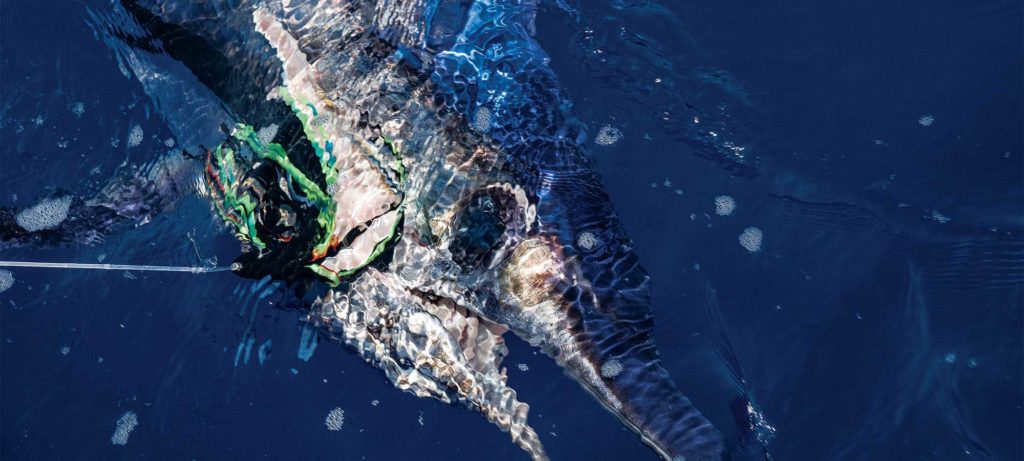
Just a short decade ago, only a small cadre of anglers knew the secrets to consistently catching broadbill swordfish after sunrise. Sure, occasional sunning fish were caught on the surface, and the seeds of daytime swordfish deep-drops were sewn off Venezuela in the 1990s, but it wasn’t until 2009, when Capt. R.J. Boyle brought me offshore for Marlin’s first article on daytime swordfishing that this technique began to take hold.
“My first catches were almost accidental,” he says about his earliest days dropping baits down 1,700 feet in 4 knots of current off Hillsboro Inlet, Florida. “I didn’t even know what a swordfish bite looked like. At first, I thought something was pecking at my bait. Then I jumped a few off, so I knew they were swords.”
After many months of trial and error, Boyle learned how to keep his baits at the bottom and reliably hook swordfish. While he is quick to acknowledge the contributions of others, particularly Vic Gaspeny and the Stanczyk family, owners of Bud N’ Mary’s Marina in Islamorada, Florida, Boyle was the first to freely share his hard-gained knowledge.
Pioneering Techniques
Electric reels dominated the early days of daytime swordfishing. “I wouldn’t have used them if I didn’t have to,” Boyle says, “but we never would have developed the techniques we use today without electric reels.” Now, some 14,000 swordfish drops wiser, he conquers daytime broadbills by hand-cranking them on light tackle.
In some ways, less water drag on 30- or 40-pound-test braided line makes swordfishing easier than using standard 80-pound-test braid, but successfully hooking a powerful billfish more than a quarter-mile beneath the waves, then bringing it to the boat on 30-pound-test tackle presents new obstacles.
To see exactly how he overcomes these technical challenges, Boyle once again brought me 16 miles east of Hillsboro Inlet to share his techniques.
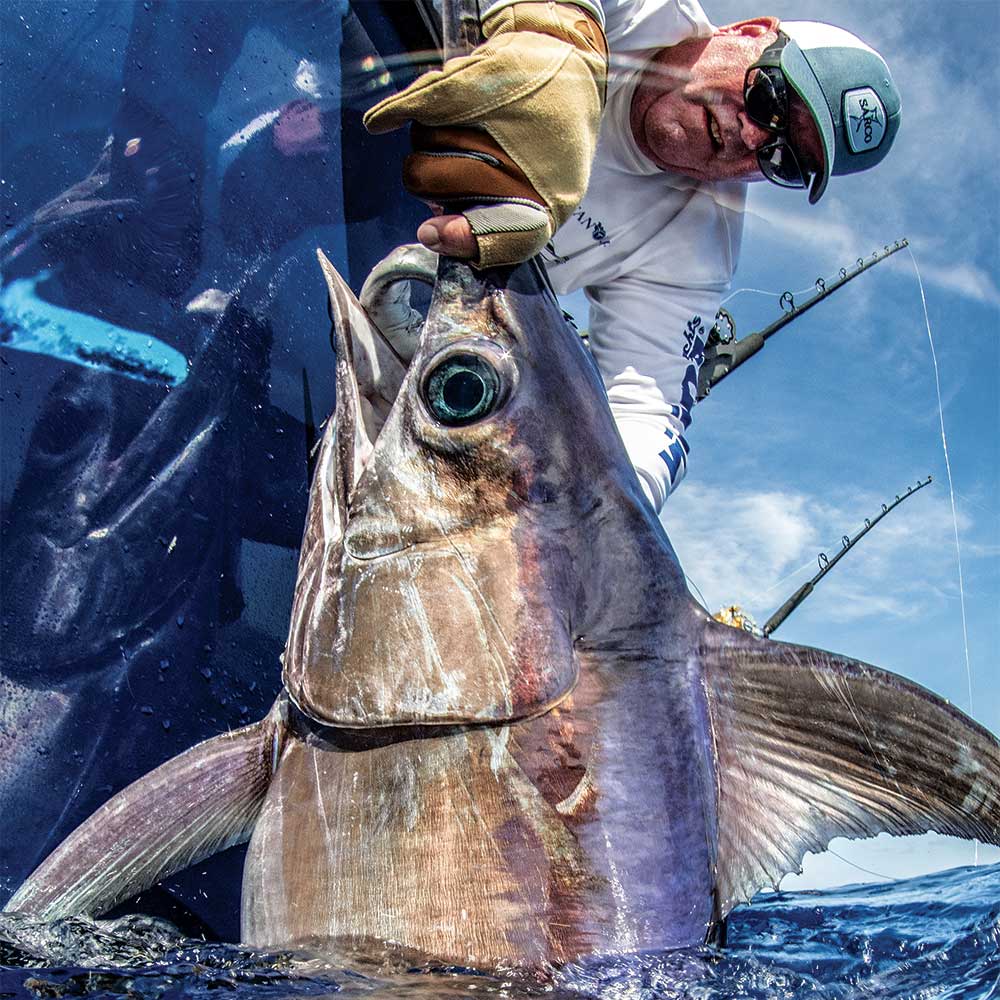
Tip-Top Tackle
“Light tackle opens up daytime swordfishing to anglers who don’t want to use electric reels,” Boyle says. He prefers Shimano Talica 50 two-speed reels for their small size and light weight on stand-up rods, but Tiagras or any similar two-speed reel works well. Requirements include a line capacity of at least 1,500 yards of 30- or 40-pound braid, the ability to smoothly sustain 20 pounds of drag for several seconds to set the hooks, and compatibility with a Reel Crankie or similar cordless-drill-powered winding system to retrieve the half-mile of line when not hooked up.
Other than using standard big-game reels, daytime swordfish tackle is specialized from the butt up. “Thirty-pound-test braid is about a quarter of a millimeter thick,” Boyle says. “That’s the thickness of 8-pound-test mono. If your rod isn’t perfect — if your guides aren’t rolling properly, if you have one scratch in your tip frame — the braid won’t hold up.”
Rods built at Boyle’s Lighthouse Point tackle store use offshore-proven components. “For light-tackle stand-up rods, you want a softer tip, so the rod bends at the top three guides to ease the strain on the angler’s back,” he says, “but you still need enough backbone from the fourth guide down to drive the hook and lift the fish.”
After testing several designs, Boyle eventually settled on composite blanks — with a fiberglass upper section and graphite below — that withstand fighting a swordfish straight up and down. “You can’t judge rod quality by looks,” he warns. “I’ve seen many rods break right where the foot of the first guide digs into the blank.”
Boyle also uses Winthrop Tackle’s Adjusta-Butts, which convert quickly from a straight butt to bent. “The longer of their two sizes fits just right in standard 10-inch rod holders. It gets the reel off the gunwale so you can wind it,” he says. The convertible butt also can increase angler comfort on long swordfish battles.
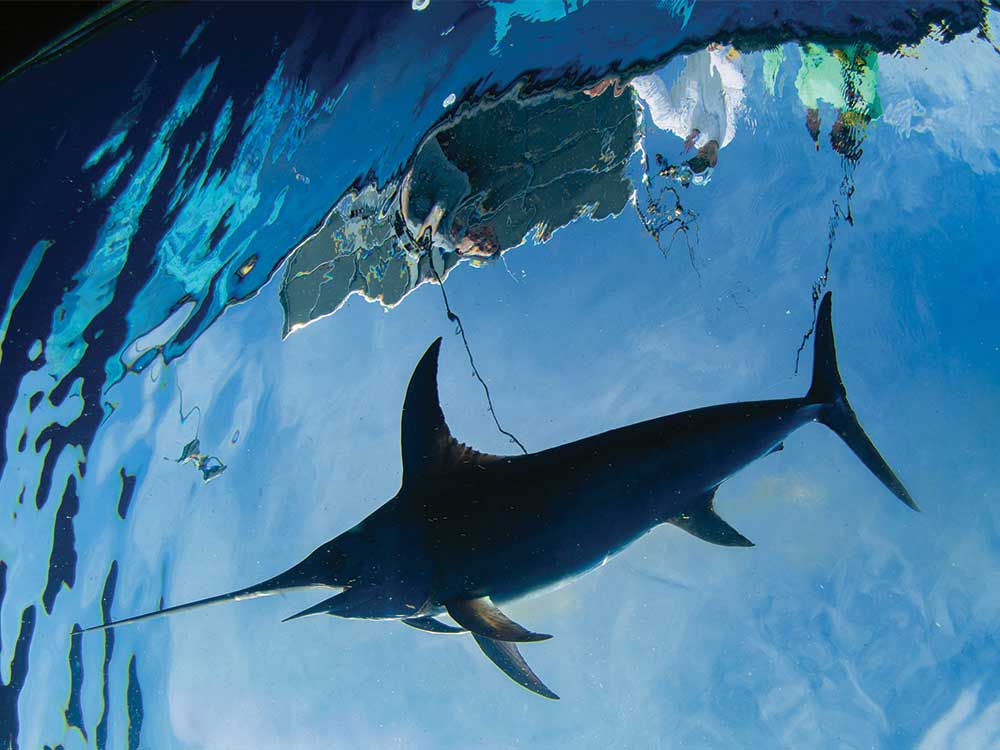
The Hillsboro High-Current Drop
What amazed me a decade ago was driving the boat south around 2 knots into the current, but actually trolling north with the Gulf Stream around 2 knots, while the bait stays near the bottom a quarter mile off the bow, ahead of the boat.
That’s unique to high-current locales, but it’s worth understanding for success elsewhere.
To begin his drop with either standard or light tackle, Boyle drives north at about 10 knots over ground — including the 4-knot-average Gulf Stream current. This keeps the bait streaming south of the lead. Once 600 feet of line comes off the reel, that weight is now beneath the strong surface layer of the Gulf Stream, down where the northward current is around 1 knot or less. Boyle then turns the boat 180 degrees, with the bow headed due south, and slows until his GPS shows at least a 1.5-knot northward troll. With just 1 knot of north current near the bottom, the bait now streams south of the boat.
With 30-pound braid and a 4-knot current, Boyle starts with a 6-pound lead. “If the top 500 feet of water is moving north at 3 knots, you’ll never hold bottom,” he explains. “It’s the thickness of the current that matters. If it’s 5 knots for only the top 200 feet, 6 pounds might be too heavy.”
Quick trial and error determine conditions for the day. “Once you hit bottom, wind up 40 feet,” Boyle says.
Without his electric-reel line counter, he uses Daiwa’s multi-colored braid, which changes color every 33 feet. “In three minutes, drop again and count the color changes. If you drop three colors — 99 feet — to hit bottom, the bait is slowly rising. Wind up around 70 feet and check it again every two or three minutes,” he says.
The opposite might be true, too. “If you drop to the bottom and wind up 40 feet, and then after three minutes you only drop 20 feet to hit bottom, the bait is sinking. Wind up 100 feet and check it every one minute, particularly if you’re coming up on rocky bottom.” Either way, adjust weight between drops as needed. “Ultimately, you want to use the lightest lead you can to hold the bait consistently 100 feet off the bottom,” he says.
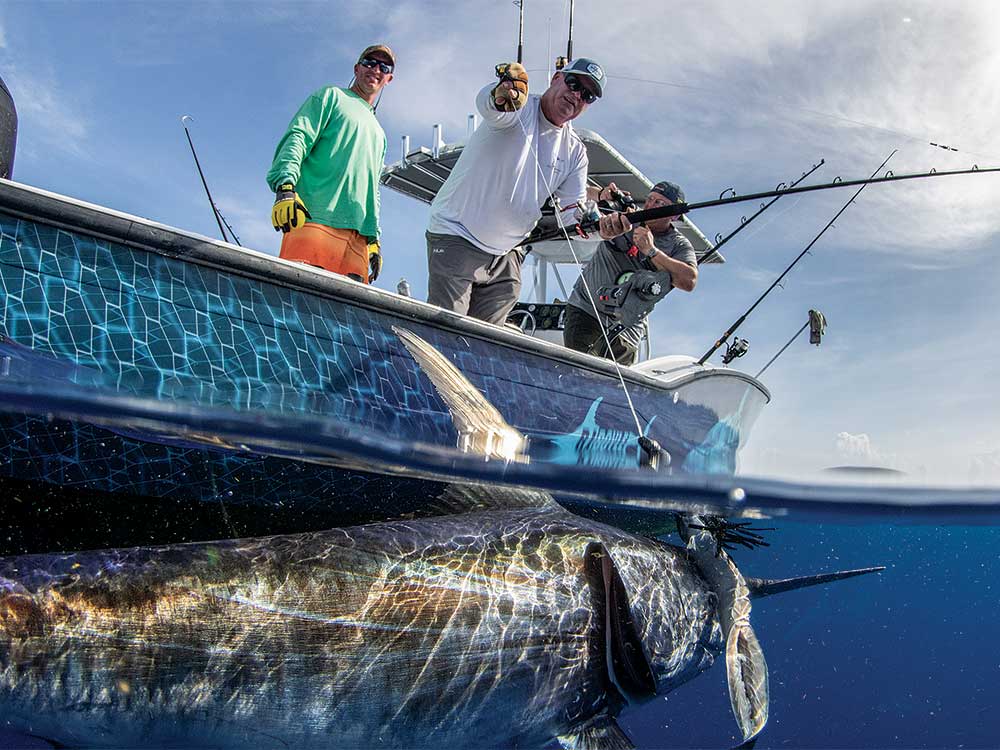
Low-Current Options
“The technical obstacles off Hillsboro were monumental at first,” Boyle says of his efforts a decade ago. “Figuring out how to overcome them in the Gulf Stream made it easy in places with no current, where those challenges don’t exist.” This now includes the East, West and Gulf coasts of the United States, across the Caribbean, in the Red Sea, the Coral Sea, the Tasman Sea and beyond. But the first time Boyle’s technique emerged from South Florida, new challenges did too.
Booby Trap owner Brett Holden and Capt. Jeff Wilson fished with Boyle off Florida before they first dropped to the bottom for swordfish in their light-current home waters off Texas, where they have since caught more than 1,000 broadbills to date. They found Boyle’s rig, with the lead 100 feet up the line from the bait, tangled badly with no current. To keep the long leader from wrapping around the main line, Holden and Wilson attach a heavy sacrificial weight — around 7 pounds of steel construction rebar — directly to baited hooks. This drags the rig down in a straight line, untangled, with the rebar rigged to detach at the bottom. An additional weight — from 1 to 3 pounds placed 60 feet from the hooks — holds the bait in the strike zone near the bottom.
Besides opening up new fishing grounds, this direct-drop method first opened the door to using light tackle. “Swordfish tire out from the 6 or 7 pounds of lead needed to keep the bait down in heavy current,” Boyle explains. “At times, you end up cranking the lead up from the bottom while fighting the fish. In light current, swordfish can swim those 2 or 3 pounds of lead around, so you’re just fighting the fish. They’ll usually swim right to the surface, and you’re getting line back on the reel quickly. That’s the beauty of places like the Gulf of Mexico. Very few guys use electric reels there now.” Fifty-pound-class conventional reels with 1,000 yards of 80-pound braid are now common.
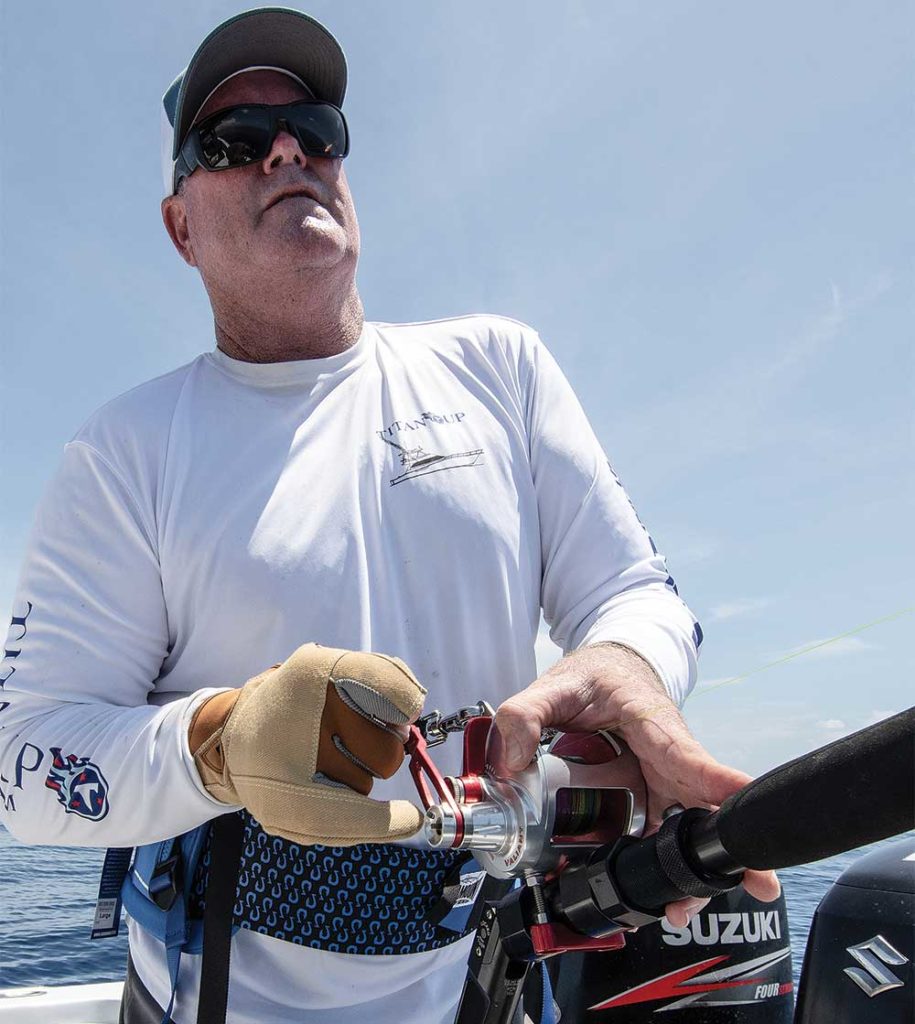
Locating Fish
“Swordfish are ambush feeders,” Boyle says. “They lay right at the edge where the bottom drops away, out of the current, and eat whatever comes by. Most bites come right where the bottom first drops off.”
With a half-mile of line in the water, however, simply reading the fish finder comes with a caveat. “If the boat is moving 1.5 knots to the north and I have 2,500 feet of line out, it takes three to five minutes for my bait to encounter whatever I’m seeing on my bottom machine directly beneath the boat,” he explains. “You don’t have to be a math student. When you see a drop-off on the bottom machine, let your line down to the bottom every minute until you know you hit that hole.”
Things change, however, without the Gulf Stream’s northward troll.
With no current, you lose the ability to cover ground. until you know exactly where the fish are, the more ground you cover, the more bites you’ll get.
“With no current, you lose the ability to cover ground,” Boyle says. “Until you know exactly where the fish are, the more ground you cover, the more bites you’ll get.”
The simple solution is to add a bit more weight and bump troll, but again, this gets complicated. “If you drive in a straight line, you’ll pull the baits up,” he explains. “They stay on the bottom if you turn a giant half circle so the lines stay at an angle to the boat.”
Working Multiple Hookups
Holden and Wilson became the first to regularly hook swordfish doubleheaders by dropping a second line as soon as the first hooks were set, and even triples by dropping a third line once two fish were hooked. “Very rarely do we get just one bite,” Holden says. “Once one swordfish feeds, they all feed.”
While it’s a bit tricky in the high current off Hillsboro, Boyle began adding more lines to get multiple bites. He suspends those lines at the right depth beneath a pair of crab-trap-like buoys clipped to the fishing line, which then stream out behind the boat.
“Once you take the current away, you can easily fish multiple rods, even with light tackle,” he says. “Deploy the buoy line first, then drive at least 50 feet away from it and set the rod that you’re fishing off the tip.” To keep multiple buoy lines apart, he decreases weight by a pound or two with each line successively farther from the boat. “If there is no current and no wind, I’ll put my farthest buoy out with no weight. Just the hook, swivel and two diamond lights pull that bait down.
“If there is an art to swordfishing, it’s the ability to put your bait into the strike zone,” he adds. “You want to approach a ledge or other bottom feature at an angle, so all your baits cross it at the same time.”
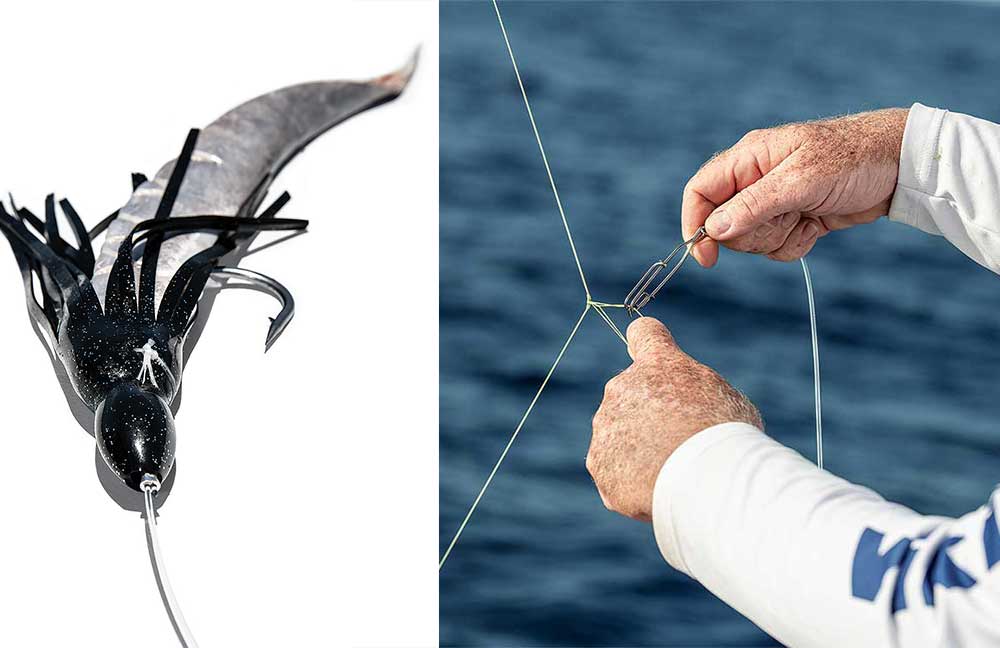
Hooking Up On Light Tackle
As Boyle learned very early on, swordfish bites are usually subtle. “It’s a vicious bill swat at the bait, but by the time it radiates through 2,000 feet of line, the rod tip bounces just a bit,” he says. “You’re looking for a bounce that’s out of rhythm from the way the rod moves in the waves. If you’re not sure, bring the line up 30 feet. Another bump confirms it’s a fish swatting the bait.”
What comes next tests light tackle. “Swordfish that come off near the boat were never hooked,” Boyle says. “With 30- or 40-pound braid and a 9/0 J hook, you have to wind up and use the boat to apply 20 pounds of drag — not just with the rod bent over, but actually pulling drag off the reel — for a full four seconds to drive that hook into the swordfish.” (With 80-pound braid, he pulls 30 pounds of drag for eight seconds to drive home a 10/0 hook). “It’s the same in heavy current, light current or no current. You must hook the fish.”
That seems counter-intuitive — billfishermen know to back drag off when big fish make hard runs with lots of line out because water resistance on that line increases the effective drag, where 10 pounds of drag at the rod might become 20 pounds at the fish. Conversely, though, applying pressure to drive a hook requires additional drag to overcome the water resistance of 2,000 feet of braid — 10 pounds of drag at the rod tip is absorbed to essentially zero drag at the hook.
There is another complication that loses swordfish on light braid.
“If the fish swims the lead up, never wind slack line,” Boyle warns. “If you do, once you come tight, that thin braid scores the braid beneath it. You might not lose that fish, but you will break off the next one.”
He prevents this in three ways. “If the line goes slack, push the throttles up so the line bellies behind the boat to create drag,” he says. “When you wind, aggressively push the line with your thumb all the way across the spool and back, so the thin braid can’t sink into the line beneath it. If you do wind in slack line, let it back out later and wind it in under pressure, or set that rod aside and use another.”
Light braid requires caution when setting drag too. “Pull about 20 feet of line off the spool, fold a piece of paper towel in thirds and wind that paper towel into your spool to create a buffer for the line beneath it,” he says.
Boyle’s meticulous attention to detail lends itself to this type of highly technical fishing, so I asked if that was a draw, for him, to daytime swordfishing.
“I didn’t really want the technical challenge,” he says. “I had to figure it out to get the reward. There is an allure to not knowing what’s happening 1,700 feet below the boat when the rod bends over. It could be a 30-pound fish, or a 1,030-pounder. That’s why I do this — to see the line finally angle up and the bill just start to come out of the water.”
Gulf Stream Dynamics
“The North Atlantic circulation that drives the Gulf Stream is primarily wind-driven,” says Dr. Mitchell Roffer, president of Fishing Oceanography, Inc. As wind patterns change, he says, the volume transport — water carried by the current — fluctuates greatly when measured at Mexico’s Yucatan Channel and again off Jupiter, Florida.
“The Gulf Stream is a lot like a balloon — squeeze one part and another bulges,” Roffer says. “More water flowing between the Bahamas and Florida can expand the Gulf Stream east to west, or vertically, or increase its velocity.”
Regional winds, in particular — blowing over the Florida Straights and the Bahamas — affect the width, depth, velocity and central axis of the Gulf Stream off Hillsboro Inlet.







